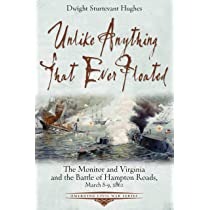By Dwight S. Hughes, Savas Beattie, Barnsley, El Dorado Hills, CA, (2021.)
Reviewed by Capt. Richard Dick, USN (RET).
Dwight Hughes’ Unlike Anything That Ever Floated is an excellent overview of the conception, hurried development, and brief (but spectacular) service of the ironclads Monitor and Virginia and the men who built, directed, commanded, and sailed in them. While not the definitive history of either ship, the book covers the human, technical, strategic, and tactical aspects of their careers well and incorporates recent discoveries from ongoing work on the recovered portions of Monitor being preserved and studied at the USS Monitor Center at the Mariners’ Museum and Park in Newport News, VA.
Hughes has previously published A Confederate Biography: The Cruise of the CSS Shenandoah (2015), and he is a contributor to the Emerging Civil War blog and has presented at numerous Civil War venues. A graduate of the U.S. Naval Academy Class of ’67, he served in Vietnam on riverine craft, on surface warships, and on service staffs (including convoy planning).
Hughes mentions the occasional development of armor-clad warships around the world and notes that the first real ironclad warship, Gloire, was launched in France in 1859, followed shortly by the iron-hulled ships HMS Warrior and HMS Black Prince in Great Britain. These vessels, stemming from lessons learned in the Crimean War (1853-1856), combined steam propulsion, screw propellers, rifled artillery, and iron plate in platforms that rendered them largely invulnerable to the attacks of sail- or steam-powered wooden ships. The United States had stayed competitive with European developments in steam power and improved artillery, in part due to the influence of Senator Stephen R. Mallory (D-FL), who would become the Confederate Secretary of the Navy and encourage the development of ironclads for the Confederacy as a force multiplier, blockade buster, and strategic threat to Northern ports.
Confederate officers and officials recognized the potential advantages associated with ironclad warships and, despite the South’s industrial disadvantages, worked feverishly to accumulate weapons and iron for warship construction. Virginia’s seizure of the Gosport Navy Yard (now Norfolk Naval Shipyard) near Norfolk, as well as the other naval facilities in the Norfolk area, provided artillery and the burned hulk and propulsion plant of the USS Merrimack, an advanced steam frigate which had been under repair at Gosport. Construction soon began on what would become the CSS Virginia, launched in February 1862.
Federal Secretary of the Navy Gideon Welles, well aware of developments in Virginia, persuaded President Lincoln and his cabinet to support the development of the design of John L. Ericsson, a Swedish engineer who had pioneered the development of screw propellors.
Ericsson’s Monitor was completed in New York in little over 100 days and, after minimal testing, was towed (and almost sunk in heavy seas) down to Hampton Roads in March 1862. The impetus to her hurried transit was the threat the Virginia presented to the Federal blockading squadron in Hampton Roads.
On March 8, 1862, Virginia emerged from the Elizabeth River. The Federals had been training for some time to expect her arrival, although they had few illusions about their ability to destroy the craft. By the end of the day, sloop USS Cumberland had sunk, frigate USS Congress had surrendered before being set on fire and sunk, and frigate USS Minnesota had run aground, an easy victim for Virginia the next day.
USS Monitor arrived in the roads that night and took station near the stranded Minnesota. The two ironclads engaged and fought each other for three hours before Monitor, her pilot house damaged and her captain wounded, pulled off toward Fort Monroe. Virginia, damaged and faced with the need to return to the Elizabeth River before the tide fell too much, retired as well. Faced with growing Federal forces around Norfolk, the Confederates withdrew from the city. Virginia drew too much to move upriver and so was destroyed. Monitor continued to serve in the Hampton Roads area until, in December 1862, she was ordered to North Carolina to support an attack on the port of Wilmington. A storm during the transit sent the ship to the bottom, along with several of her crew.
Hughes’ book tells the story superbly as popular history, although one could wish for an index and footnotes. It is richly illustrated and includes excellent drawings and maps. While the book would benefit from color illustrations and a larger format to improve the presentation of the photographs and maps, the present format is a reasonable compromise between presentation and affordability. Hughes also includes a good supplemental reading list, description of the raising and preservation of the Monitor, and a list of suggested sites to visit in order to explore the history of the two vessels.
Captain Dick, USNA ’75, is a retired submariner; he also served over 29 years in the defense intelligence community in scientific and technical intelligence, intelligence support to the acquisition process, and foreign materiel.
Dwight Sturtevant Hughes writes and speaks on Civil War naval history (www.CivilWarNavyHistory.com). Lieutenant Commander Hughes graduated from the Naval Academy in 1967 and served twenty years aboard warships, on navy staffs, and with river forces in Vietnam. He holds an MA in Political Science and an MS in Information Systems Management. Dwight authored A Confederate Biography: The Cruise of the CSS Shenandoah (Naval Institute Press, 2015) and is a contributing author at the Emerging Civil War blog (www.emergingcivilwar.com).
Unlike Anything that Ever Floated: The Monitor and Virginia and the Battle of Hampton Roads. By Dwight S. Hughes, Savas Beattie, Barnsley (El Dorado Hills, CA: 2021.)


